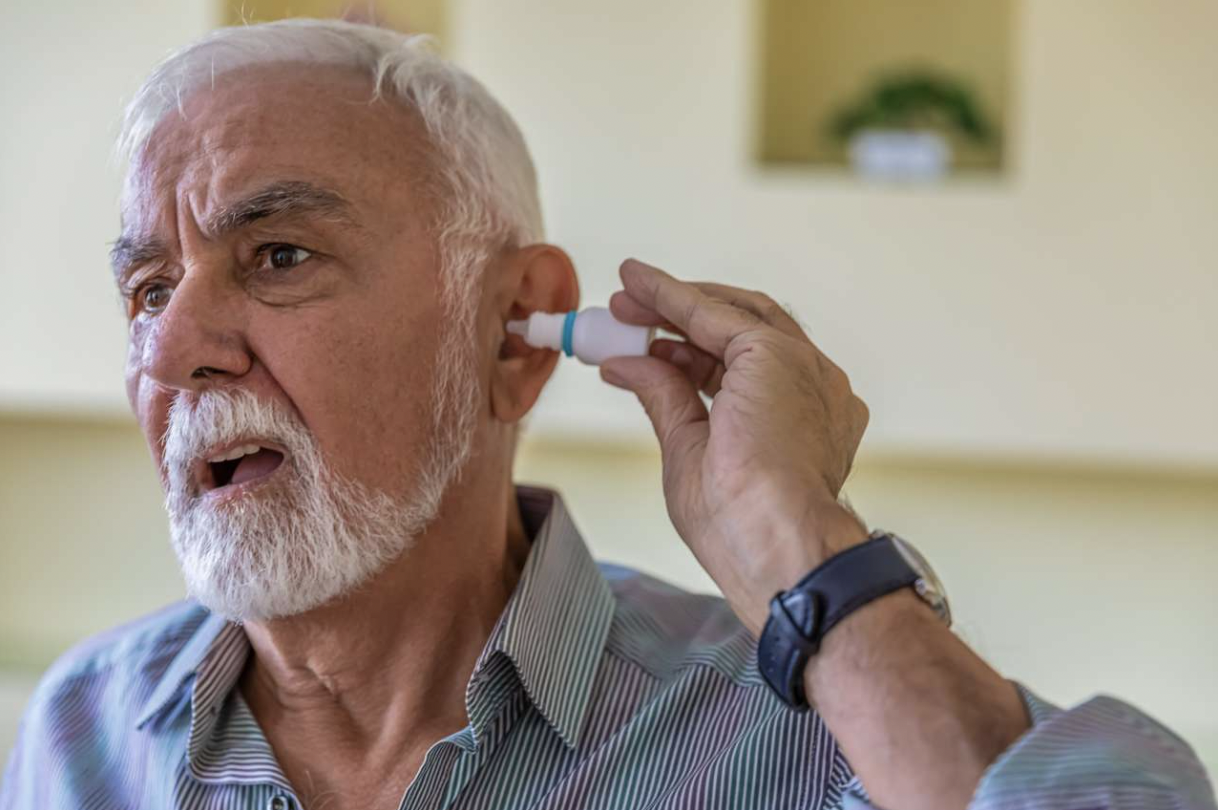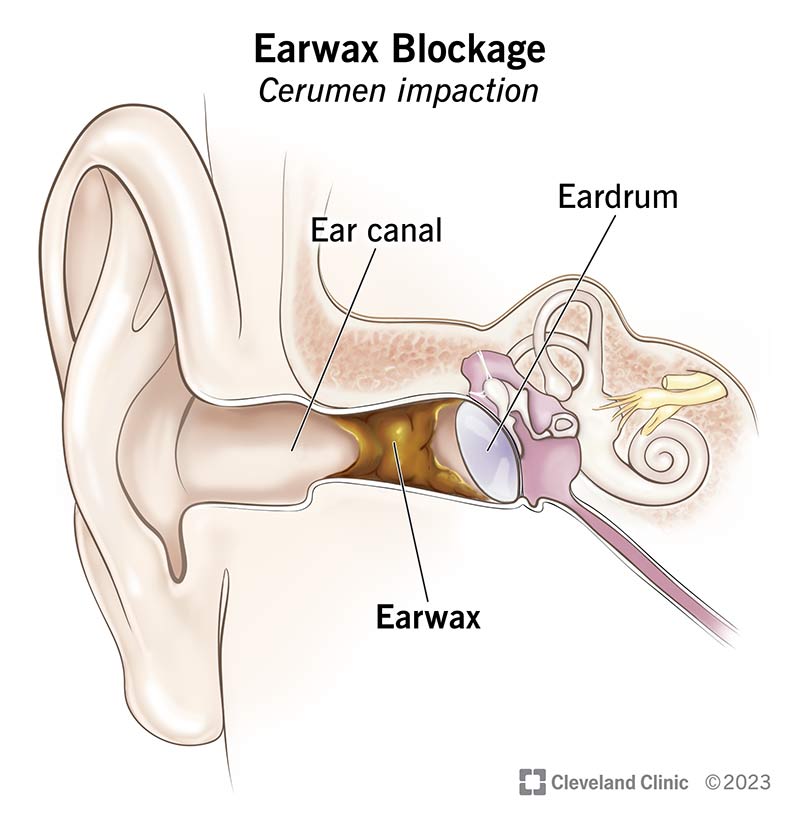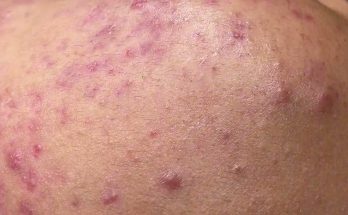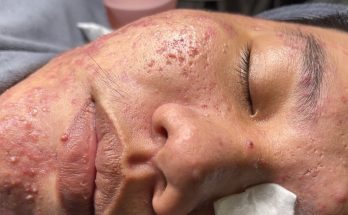
Earwax (also called cerumen) is your ear’s natural protectant. But it can be tricky. Earwax can interfere with hearing, cause infections and be downright uncomfortable. Many people think it’s dirty and can’t fight the urge to clean it out, especially if they feel or see it.
But removing or dislodging earwax when there isn’t a medical issue can cause problems deep within your ear. To help you navigate the do’s and don’ts of earwax and ear cleaning, we’ve put together six facts you should know:
1. Earwax is important
Your ear canal has tiny hair and glands that naturally secrete waxy oil. Earwax protects the canal and inner ear as a moisturizer, lubricant and water repellant.
When you use your jaw to talk or chew, the motion helps move the wax toward your ear’s outer opening, where it can drain out. Along the way, the wax gathers and removes harmful dirt, cells and dead skin that can lead to infection.
2. Most people don’t need to clean their ears
Unless the wax in your ears forms a blockage, you shouldn’t have to go out of your way to clean them. Once earwax naturally moves toward the opening of the ear canal, it typically falls out or washes away.
Washing your hair is usually enough to remove the wax on your ear’s surface. During a shower, a small amount of warm water enters the ear canal and loosens any wax accumulated there. Use a damp washcloth to wipe away any wax outside your ear canal.
3. Impacted earwax can be painful
About 5% of adults have excessive or impacted earwax. Some people naturally produce more earwax than others. And earwax that doesn’t move quickly or gathers too much dirt along the way can get hard and dry. Other people produce an average amount of wax, but it can get impacted when earbuds, earplugs or hearing aids interrupt the natural flow.
No matter why it builds up, impacted earwax can affect your hearing and cause discomfort. If you have impacted earwax, you may experience symptoms including:
- Ear aching
- Ringing in the ear
- Impaired hearing
- Odor
- Dizziness
- Coughing
4. Cotton swabs can be bad for your ears
You may be tempted to grab a cotton swab and go to work removing wax as soon as you see or feel it. But you are likely doing more harm than good. Using cotton swabs can:
- Disrupt the tiny hairs that protect the ear canal
- Push wax deeper into the ear canal
- Traumatize the fragile ear canal skin and lead to infection or bleeding
Cotton swabs can help clean the outside of the ear. Just be sure not to insert them into the ear canal.
5. Health care providers can safely remove impacted earwax
Earwax removal is the most common otolaryngologic (ear and throat) procedure performed by primary care physicians (PCPs) in the United States. Your physician knows how to soften and safely remove earwax using special instruments such as a wax spoon, suction device or ear forceps — a long thin tool used to grab earwax.
6. There are safe ways to remove earwax at home
If earwax build-up is common for you, your health care provider may recommend removing it regularly at home before it becomes impacted. You can remove earwax safely at home with:
Softening drops
Over-the-counter ear drops — which often contain hydrogen peroxide as the main ingredient — can help soften hardened wax. Your physician can tell you how many drops to use each day and how many days to use them.
Your PCP may advise against using ear drops if you have:
- A history of recurrent ear infections
- Holes in your eardrums
- Prior ear surgery
Ear irrigation
Irrigating (gently rinsing) your ear canal can reduce the risk of earwax impaction. It involves using a rubber bulb syringe to squirt water or a saline solution into the ear canal. When the water or solution drains out of the ear, it also flushes out loose ear wax.
Use wax-softening ear drops before rinsing out your ear for the best results. And be sure to warm the solution to your body temperature. Cold water can stimulate the vestibular nerve (related to motion and position) and cause dizziness. If you still have symptoms of earwax impaction after flushing your ear, contact your PCP.
Earwax Blockage
Untreated earwax buildup can lead to hearing loss, irritation, pain in your ear, dizziness, ringing in your ears and other issues. In most cases, earwax impaction isn’t dangerous and symptoms go away with treatment. Earwax blockage treatments include drops to soften the wax or manual removal at your healthcare provider’s office.
Overview

What is cerumen impaction?
“Cerumen impaction” is the medical term for earwax blockage. Earwax (cerumen) plays an important role in ear health. It cleans your ears and protects them from dust, dirt and infection.
Despite its many benefits, earwax can cause issues if too much of it builds up. Cerumen impaction may result in ear pain, itchiness, ringing in your ears, hearing loss or other issues. When necessary, a healthcare provider can help you with earwax removal.
Who is most likely to develop impacted earwax?
Earwax blockage can happen to anyone. About 10% of children and 5% of adults have it.
Impacted cerumen is more likely to occur in people who:
- Use hearing aids, earplugs or earbuds.
- Have a lot of ear hair.
- Have certain skin conditions like eczema.
- Put cotton swabs or other items into their ears.
- Are over the age of 55.
- Have developmental disabilities.
- Have misshapen ear canals that interfere with natural wax removal.
Symptoms and Causes
What are the symptoms of cerumen impaction?
Impacted earwax symptoms may include:
- A feeling of fullness in your ear.
- Pain in your ear (earache).
- Hearing loss, which may worsen over time.
- Ringing in your ears (tinnitus).
- Itchiness in your ears.
- Discharge or odor coming from your ears.
- Dizziness.
What causes earwax buildup?
Some people get earwax buildup simply because they naturally produce more earwax.
You can also get earwax impaction if:
- You have dry or hard earwax.
- You have a lot of ear hair.
- You have narrow ear canals.
- You frequently wear earplugs or hearing aids.
- You routinely use cotton swabs to clean your ears.
What happens if impacted earwax is not removed?
If left untreated, excessive earwax may cause earwax impaction symptoms to worsen. These symptoms might include hearing loss, ear irritation, tinnitus and other issues. A buildup of earwax might also make it difficult to see into your ear, which may result in potential issues going undiagnosed.
Diagnosis and Tests
How is cerumen impaction diagnosed?
Your healthcare provider will perform a physical examination. During this visit, they’ll look into your ears with a special instrument, called an otoscope, to see if earwax buildup is present.
Management and Treatment
How do you get rid of impacted earwax?
Impacted cerumen treatments involve both at-home and in-office methods, including:
- Solutions that dissolve earwax.
- Ear irrigation.
- In-office earwax removal.
Talk to your healthcare provider before trying any treatment.
Clean your ears properly
Clean the outside of your ear with a washcloth. After showering or bathing, dry your ears as much as possible.
You should never, under any circumstances, put anything inside your ear canal — including cotton swabs. Not only can using cotton swabs damage your eardrum, but it can also encourage your ears to make more earwax. (Learn more about why you should avoid cotton swabs in “Additional Common Questions” below.)
Use solutions to dissolve earwax
You can use cerumenolytic solutions (solutions to dissolve wax) in your ear canal. These solutions include:
- Saline solution.
- Baby oil.
- Glycerin.
- Mineral oil.
- Hydrogen peroxide or peroxide-based ear drops (such as Debrox®).
With these solutions, you put a few drops into the affected ear and lie on the opposite side. This way, the solution can drip into your affected ear. These oils should be used sparingly. If using an over-the-counter earwax removal, follow the directions provided.
Ear irrigation
Another option is irrigating or syringing your ear. This involves using a syringe to rinse out your ear canal with water or saline solution. Generally, you should soften the wax first by using a cerumenolytic solution. Then, you’ll gently irrigate your ear with a bulb syringe.
In-office earwax removal
Finally, your healthcare provider can remove earwax manually using special instruments. They might use a cerumen spoon, forceps, irrigation or a suction device. Generally, these procedures only take a few minutes to complete.
Prevention
How can I prevent earwax buildup?
Don’t stick anything into your ears to clean them. If you use cotton swabs, you should only use them on the outer part of your ear. If a healthcare provider has to remove earwax from your ears more than once a year, ask them what they suggest to stop earwax from building up.
Outlook / Prognosis
What can I expect if I have impacted cerumen?
Though impacted cerumen is annoying and inconvenient, it usually isn’t dangerous. Still, you should call a healthcare provider if you notice impacted earwax symptoms like ear pain, dizziness or hearing loss.
Some people produce more earwax than other people and may need routine treatments to remove it. Talk to your provider about ways to soften earwax and keep your ears healthy.
Living With
When should I see my healthcare provider?
Call a healthcare provider if you develop cerumen impaction symptoms such as ear pain, itchiness, tinnitus, dizziness, hearing loss or a feeling of fullness in your ears.
You should seek medical care immediately if you have:
- Fever.
- An earache that doesn’t go away.
- Drainage coming out of your ear (otorrhea).
- A foul odor coming from your ear.
What questions should I ask my healthcare provider?
Your healthcare provider can tell you how to get rid of earwax buildup. Here are a few questions you may want to ask:
- Do my ears make excessive amounts of earwax?
- How can I safely and thoroughly clean my ears?
- Can I prevent earwax from building up?
- What home remedies do you recommend?
- Do I need professional earwax removal?
- Should I have earwax removed on a regular basis?
Additional Common Questions
Can I use cotton swabs to remove excess earwax?
Many people use cotton swabs to clean their ears. But research shows that cotton swabs can actually cause more earwax production. This is because cotton swabs stimulate the tiny hairs inside your ear canal. When you stimulate these hairs, they send messages to the glands inside your ear canal to make more earwax.
What else should I avoid when treating earwax impaction?
Don’t use suction devices for home use (such as Wax-Vac®). They aren’t effective for most people and most healthcare providers don’t recommend them.
Ear candles, advertised as a natural method to remove earwax, are ineffective. They can also cause injuries such as burns to your external ear and ear canal. They may even perforate (tear) your eardrum.
A note from Cleveland Clinic
Remember, earwax on its own isn’t bad. It cleans your ears and keeps them from getting infected. However, if earwax builds up, it can cause issues like irritation, itchiness and hearing loss. It’s only safe to clean the outside of your ears and to use drops or water to soften earwax. You should always contact your healthcare provider to remove earwax using an instrument.


